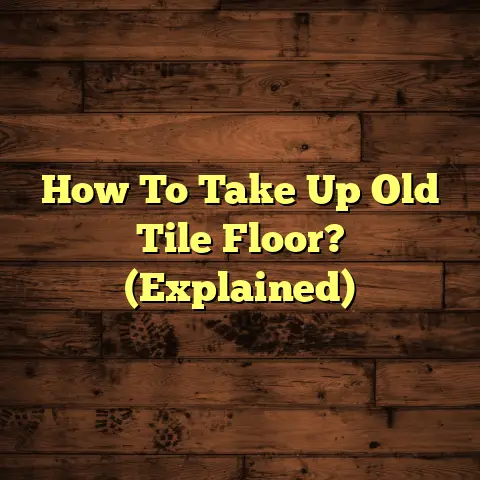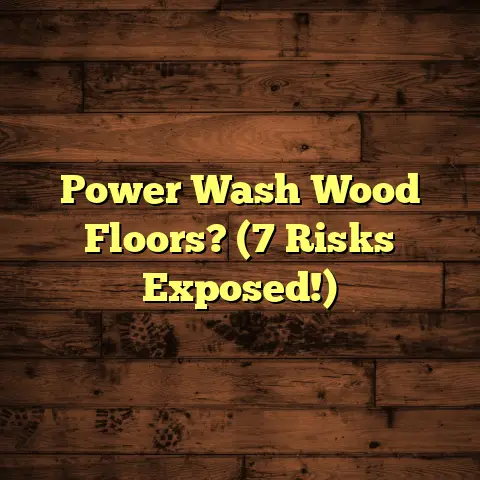Web Floor Truss Cost Guide (4 Costly Upgrades!)
I’m a flooring contractor and I’m here to talk floors. Specifically, web floor trusses!
Flooring systems are the unsung heroes of any building, providing the foundation for everything else.
Did you know that, according to the National Association of Home Builders, over 75% of new homes in the United States use engineered wood products, including web floor trusses, for their structural integrity?
That’s a huge number!
So, understanding the costs associated with these systems is crucial, which is why I’ve put together this guide.
Let’s dive in!
Section 1: Understanding Web Floor Trusses
So, what exactly are web floor trusses?
Imagine a floor joist, but instead of a solid piece of lumber, it’s a network of interconnected wood or metal members.
That’s a web floor truss!
They differ from traditional floor joists in a few key ways.
Traditional joists are solid pieces of lumber, while trusses are engineered systems.
This engineering allows trusses to span longer distances, handle heavier loads, and provide more consistent performance.
Think of it like this: a single wooden beam might sag under a heavy load.
But a truss, with its triangular web of supports, distributes the weight evenly, making it much stronger.
Materials and Benefits
Web floor trusses are typically made from wood, metal, or a combination of both.
Wood trusses often use oriented strand board (OSB) or plywood for the web, combined with solid lumber for the top and bottom chords.
Metal web trusses, on the other hand, use steel or aluminum for the entire structure.
Each material has its own set of benefits.
Wood is cost-effective and easy to work with, while metal offers superior strength and fire resistance.
The biggest advantage of web floor trusses is their performance.
The engineering ensures that the floor is level, stable, and capable of handling the loads it’s designed for.
Plus, the open web design makes it easier to run plumbing, electrical, and HVAC systems, which can save you time and money during construction.
Section 2: Overview of Costs Associated
with Web Floor Trusses
Okay, let’s talk money!
The base cost for web floor trusses can vary depending on several factors, but generally, you can expect to pay anywhere from $4 to $10 per square foot.
Think of it like buying a car: there’s a base model, and then there are all the optional features that can drive up the price.
Factors Influencing Base Cost
Several factors can influence the base cost of web floor trusses.
-
Material Quality: Higher-grade lumber or steel will obviously cost more.
-
Design Complexity: Simple rectangular trusses are cheaper than complex designs with multiple angles or unusual spans.
-
Local Market Conditions: Prices can vary depending on the supply and demand in your area.
-
Labor Costs: Installation costs will depend on the local labor rates and the complexity of the job.
For example, I worked on a project in California where the cost of labor was significantly higher than a similar project I did in Texas.
That difference alone added about 15% to the overall cost of the floor system.
Web Floor Trusses vs. Alternatives
When compared to traditional floor joists, web floor trusses may seem more expensive upfront.
However, when you factor in the long-term benefits, they can actually be more cost- effective.
Think about it: with traditional joists, you might need to add extra supports to achieve the same span and load-bearing capacity as a truss.
Plus, running utilities through solid joists can be a real pain, requiring you to drill holes and potentially weaken the structure.
With trusses, the open web design makes it easy to run pipes and wires, saving you time and money on labor.
Section 3: The 4 Costly Upgrades
Now, let’s get to the heart of the matter: the upgrades that can significantly impact the cost of your web floor truss system.
1. Upgrade #1: Enhanced Load-Bearing Capacity
Sometimes, standard load-bearing capacity just isn’t enough.
If you’re planning on installing heavy machinery, large appliances, or a waterbed, you’ll need to upgrade your trusses to handle the extra weight.
This upgrade involves using stronger materials, adding more supports, or increasing the size of the truss members.
The additional cost can range from 10% to 30% above the base cost, depending on the specific requirements.
Long-Term Benefits:
-
Safety: Ensures the floor can safely support the intended load.
-
Durability: Prevents sagging or structural damage over time.
-
Peace of Mind: Knowing your floor is built to handle anything you throw at it.
I once worked on a project where the client initially balked at the cost of upgrading the load-bearing capacity.
However, after I explained the potential consequences of not doing so (sagging floors, cracked ceilings, even structural failure), they quickly changed their mind.
In the end, they were grateful they invested in the upgrade, as it saved them from costly repairs down the road.
2. Upgrade #2: Acoustic Treatment
If you’re building a multi-family unit, a commercial space, or even just a home theater, sound insulation is crucial.
No one wants to hear their neighbor’s TV or the footsteps of people walking overhead.
Acoustic treatment in conjunction with web floor trusses involves adding sound-dampening materials to the floor system.
This can include:
-
Soundproof Underlayment: A layer of dense material placed between the subfloor and the finished flooring.
-
Insulation: Filling the cavities within the trusses with fiberglass, mineral wool, or spray foam insulation.
-
Resilient Channels: Metal strips that isolate the ceiling from the floor structure, reducing sound transmission.
The cost of acoustic treatment can vary widely depending on the level of soundproofing you’re trying to achieve.
Generally, you can expect to pay anywhere from $2 to $5 per square foot for this upgrade.
Cost Implications:
-
Material Costs: Soundproof underlayment, insulation, and resilient channels can add to the overall material costs.
-
Labor Costs: Installing these materials requires additional labor, which can increase the overall project cost.
I remember a project where we installed soundproof underlayment in a condo building.
The tenants were thrilled with the results, as it significantly reduced the noise from their neighbors.
One tenant even told me that it was the best investment the building had ever made!
3. Upgrade #3: Integrated HVAC Ducting
Integrating HVAC ducting within the floor truss system can streamline construction and save space.
Instead of running ductwork below the floor, you can run it through the open web of the trusses.
This can be especially beneficial in buildings with limited headroom or where you want to maximize ceiling height.
However, this upgrade requires careful planning and coordination between the truss manufacturer, the HVAC contractor, and the general contractor.
The cost of integrating HVAC ducting can range from $1 to $3 per square foot, depending on the complexity of the ductwork and the size of the trusses.
Cost Analysis:
-
Material Costs: You may need to use specialized ductwork or insulation to fit within the trusses.
-
Labor Costs: Installing ductwork within trusses can be more labor-intensive than traditional ductwork installation.
-
Design Costs: Integrating HVAC ducting requires careful design and coordination, which can add to the overall design costs.
I’ve seen projects where integrating HVAC ducting saved thousands of dollars by eliminating the need for dropped ceilings or other space-consuming solutions.
It’s definitely something to consider if you’re looking to maximize space and efficiency.
4. Upgrade #4: Advanced Moisture Resistance
In areas prone to high humidity or water exposure, moisture resistance is essential.
Moisture can cause wood to rot, metal to rust, and mold to grow, all of which can compromise the structural integrity of your floor system.
To combat this, you can use treated materials or add additional moisture barriers during installation.
Treated lumber is impregnated with chemicals that resist decay and insect infestation.
Moisture barriers, such as polyethylene sheeting or waterproof membranes, can be installed between the subfloor and the trusses to prevent moisture from penetrating the structure.
The cost of advanced moisture resistance can range from $0.50 to $2 per square foot, depending on the materials used and the level of protection required.
Costs Involved:
-
Material Costs: Treated lumber and moisture barriers can add to the overall material costs.
-
Labor Costs: Installing moisture barriers requires additional labor, which can increase the overall project cost.
I once worked on a project near the coast where moisture was a major concern.
We used treated lumber for all the floor trusses and installed a waterproof membrane between the subfloor and the trusses.
It was a bit more expensive upfront, but it gave the homeowners peace of mind knowing that their floor system was protected from the elements.
Section 4: Total Cost Considerations for Web
Floor Truss Systems
Okay, let’s put it all together!
The total cost of your web floor truss system will depend on the base cost, plus the cost of any upgrades you choose.
Let’s look at a couple of examples:
Example 1: Typical Residential Project
-
Project: 2,000 square foot home in a suburban area.
-
Base Cost: $6 per square foot = $12,000
-
Upgrades:
- Enhanced Load-Bearing Capacity (10%): $1,200
- Acoustic Treatment (Soundproof Underlayment): $4,000
-
Total Cost: $12,000 + $1,200 + $4,000 = $17,200
Example 2: Commercial Project
-
Project: 5,000 square foot office building in a city center.
-
Base Cost: $8 per square foot = $40,000
-
Upgrades:
- Enhanced Load-Bearing Capacity (20%): $8,000
- Acoustic Treatment (Insulation and Resilient Channels): $15,000
- Integrated HVAC Ducting: $7,500
- Advanced Moisture Resistance (Treated Lumber): $2,500
-
Total Cost: $40,000 + $8,000 + $15,000 + $7,500 + $2,500 = $73,000
These are just examples, of course.
Your actual costs may vary depending on your specific project requirements, location, and other factors.
Section 5: Conclusion
So, there you have it!
A comprehensive guide to web floor truss costs and the upgrades that can significantly impact your budget.
Understanding these costs is crucial for making informed decisions and avoiding surprises down the road.
Remember, investing in a quality flooring system is an investment in the long-term durability, energy efficiency, and overall value of your building.
A well-designed and properly installed floor system can save you money on maintenance, reduce energy costs, and improve the comfort and safety of your space.
Call to Action
If you’re planning a construction project, I encourage you to consider web floor trusses for your flooring system.
And don’t hesitate to consult with a qualified flooring contractor to get accurate estimates based on your specific needs.
I hope this guide has been helpful!
Good luck with your project!





